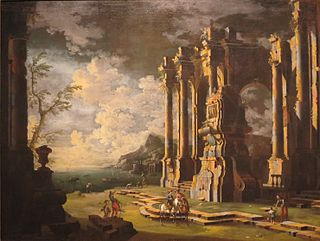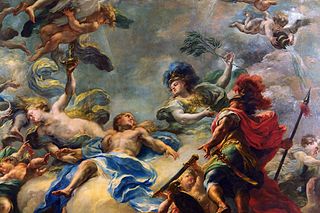
Francesco Solimena was a prolific Italian painter of the Baroque era, one of an established family of painters and draughtsmen.
Aniella di Beltrano or Anniella di Rosa (1613–1649) was an Italian woman painter of the Baroque period, active in Naples. She trained with Massimo Stanzione, who was a fellow pupil with her husband, Agostino Beltrano (1616–1665). It is said that her husband stabbed her to death in a fit of jealousy. Her recognized output of paintings is minimal. Attributed to her by Grossi were the ceiling paintings of the Birth and Death of the Virgin for the church of Pietà dei Turchini; the portrait of San Biago in the church of the Sanità.
Pietro Capelli or Pietro Cappelli was an Italian painter of the Rococo, active in his native city of Naples. He trained under Francesco Solimena. He was active in quadratura, but also painted capricci and canvases with landscapes.
Gabriele Ricciardelli, was an Italian painter of the Baroque period, active mainly in depicting landscapes.

Leonardo Coccorante (1680–1750) was an Italian painter known for his capricci depicting imaginary landscapes with ruins of classical architecture.

Domenico Brandi (1683–1736) was an Italian painter, active in his native Naples, where he painted still lifes of birds and animals, as well as pastoral landscapes (vedute) and a bambocciata. He was the son of the painter Gaetano Brandi, and Domenico initially trained with his uncle, Niccola Maria Rossi, in Naples. He later moved to work under Benedetto Luti in Rome. He was a painter to the Viceroy d'Harrach of Naples, and died in the latter city.

Giacomo del Pò, also spelled del Po, was an Italian painter of the Baroque. He was born in Palermo, the son of Pietro del Pò who was also his teacher.

Pompeo Cesura, also known as Pompeo Dall'Aquila or Pompeo Aquilano, was an Italian painter and engraver. It is stated in the 'Abecedario Pittorico' by Orlandi to have been a painter of history, specializing both in oil and fresco. He flourished in the latter part of the 16th century. There is a painting by him in the church of Santo Spirito in Sassia in Rome, representing the Deposition, which was engraved by Orazio de Santis in 1572. Several frescoes by him can be viewed in his birthplace of L'Aquila, Abruzzo.

Giacinto Diano or Diana was an Italian painter, active in Southern Italy in a style that mixes Rococo and Neoclassicism.
Marco Mazzaroppi (1550–1620) was an Italian painter, mainly painting religious subjects.

Domenico Mondo was an Italian painter, active in both a late Baroque and Neoclassical styles.
Silvestro Morvillo, also called il Bruno or Silvestro Bruno was an Italian painter of the late-Renaissance period in Naples. Morvillo studied under Giovanni Bernardo Lama. One of his pupils was Antonio Sensibile born 1537.
Luigi Carboni (1540-1600) was an Italian painter of the late-Renaissance period, depicting mainly landscapes. Carboni was born in Marcianise in Campania, and moved to Rome where he worked under and learned from the Flemish Paul Bril. Grossi describes his landscapes as depicting:
(the) flood of rivers, fall of lightning, the impetuous winds, the storms, and the lansdscapes granted with noble figures, amaze and delight the viewer...
Michele Foschini was an Italian painter, active in a late Baroque style.
Nicola Casissa was an Italian painter, active in Campania and Naples as a painter of still-life scenes of fruits, flowers, and birds.
Francesco Calò was an Italian painter of the late-Baroque period.
Girolamo Starace was an Italian painter of the late-Baroque period, active mainly in Naples.
Filippo Castaldi was an Italian portrait painter of the late-Baroque period, active mainly in Southern Italy and Poland.

Marco Caricchia was an Italian painter of the late-Baroque period, active mainly in Southern Italy and Rome. He was active mainly in portraits and manuscript illumination.
Giorgio Garri was an Italian painter, active in Naples as a painter of still-life scenes of fruits, flowers, and birds.







